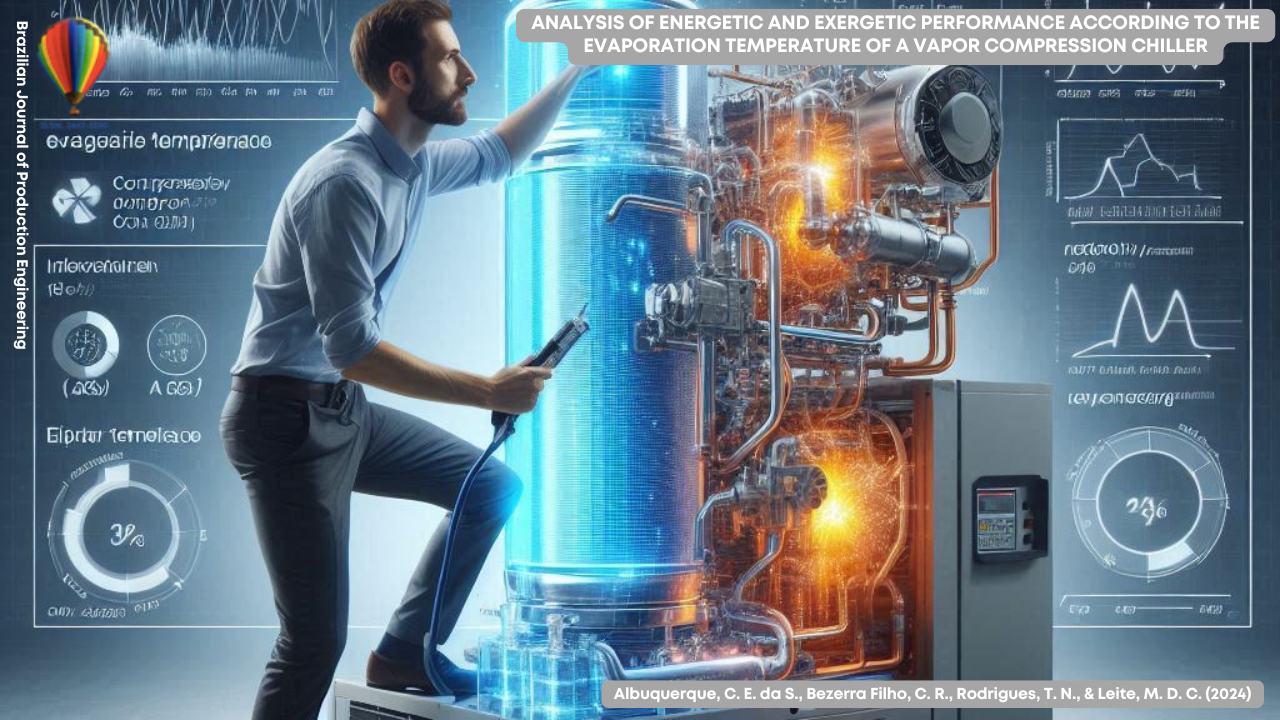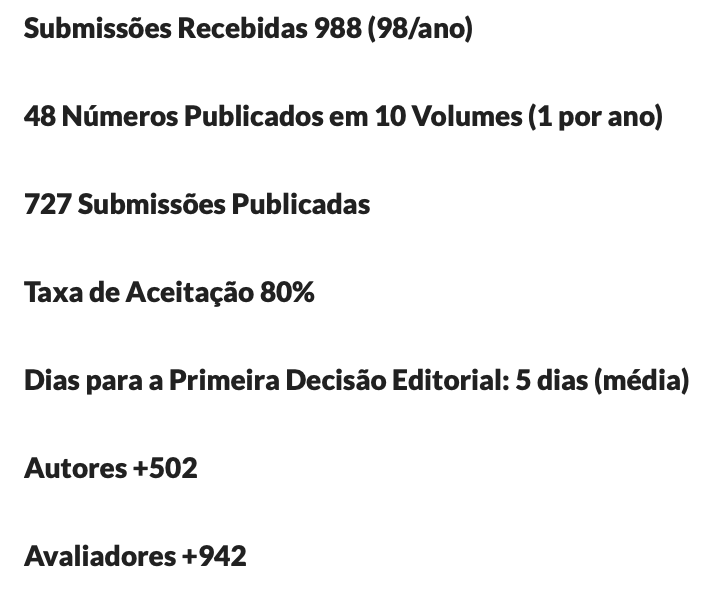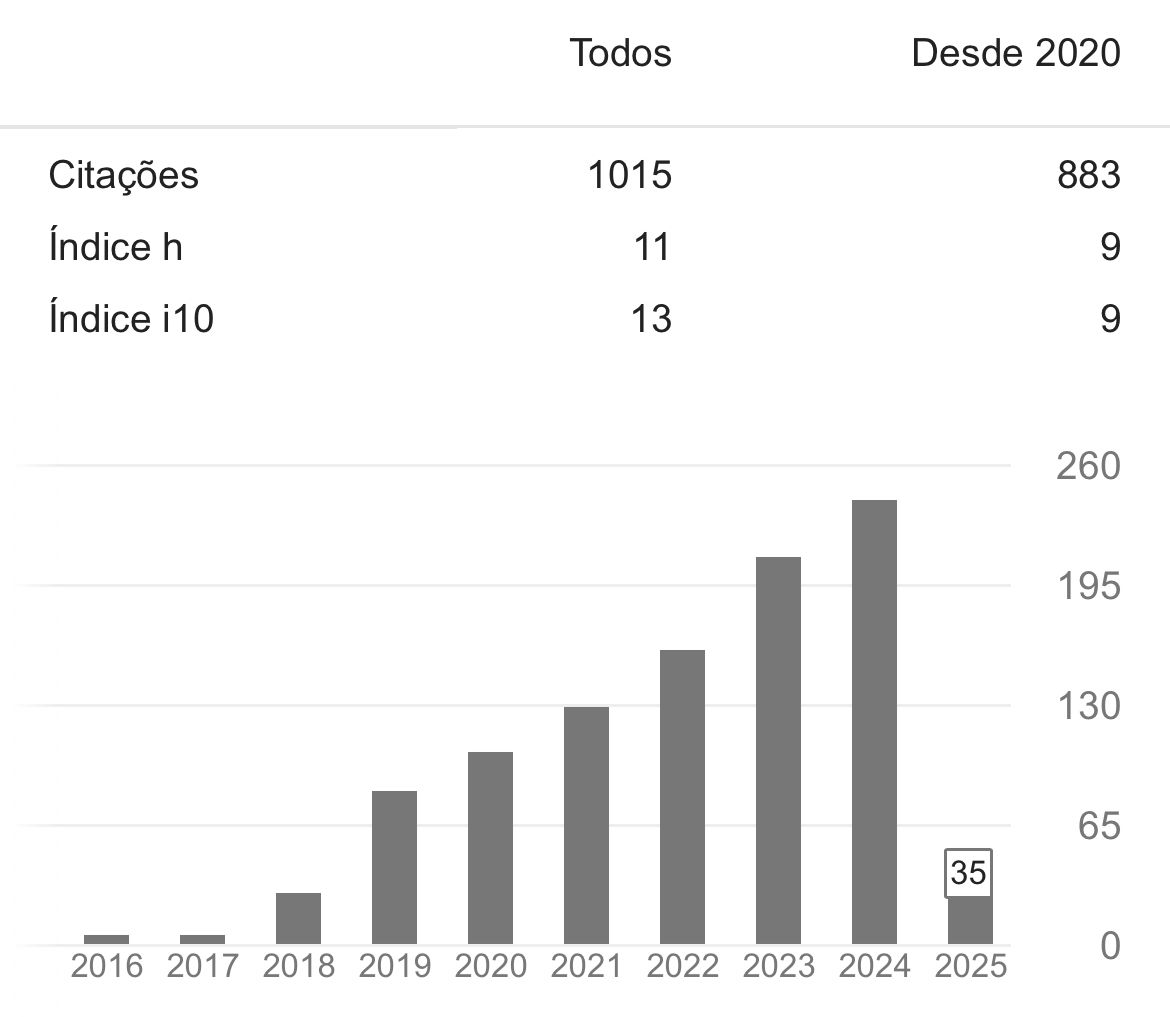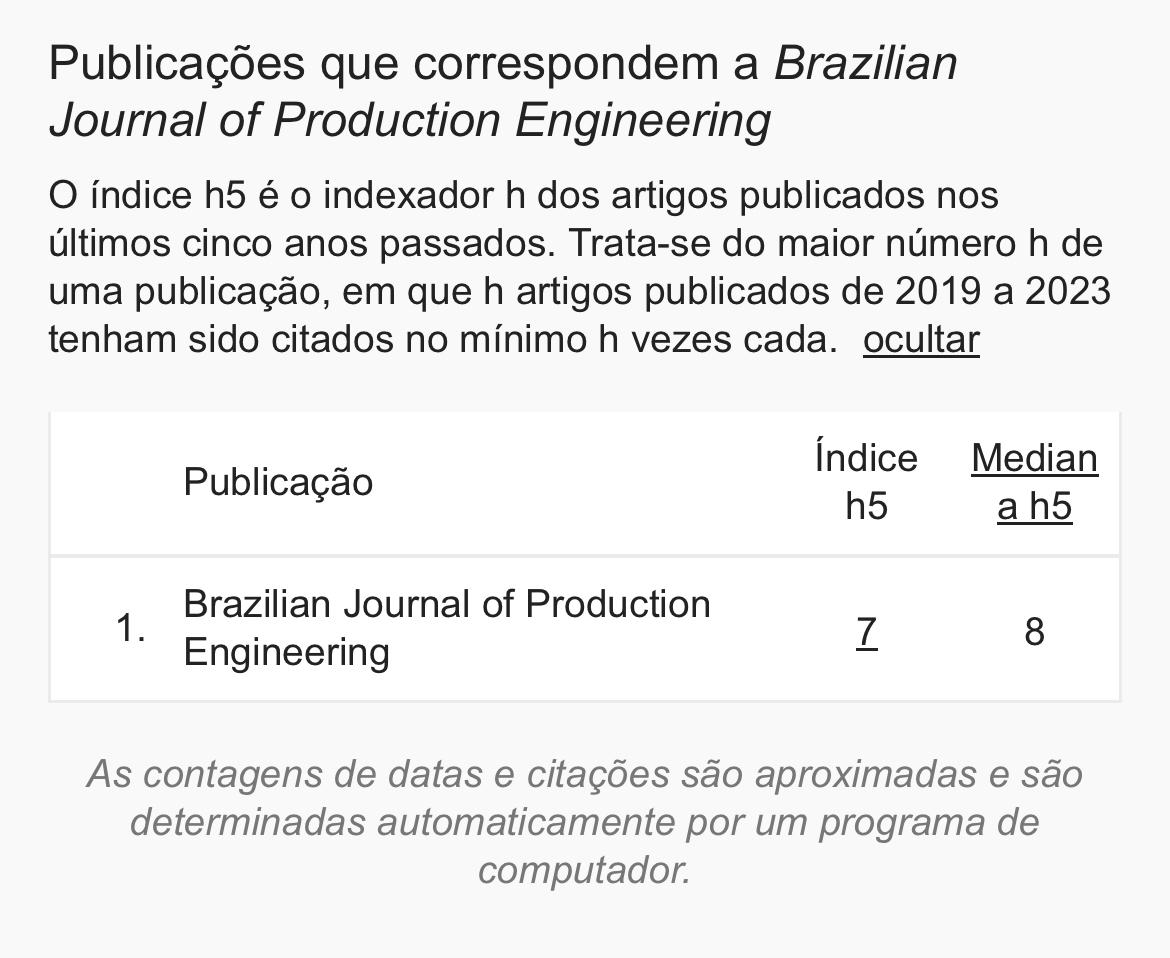Analysis of energetic and exergetic performance according to the evaporation temperature of a vapor compression chiller
DOI:
https://doi.org/10.47456/bjpe.v10i3.44651Palavras-chave:
Chiller screw compressor, Energy efficiency, Exergy efficiency, Evaporation temperatureResumo
This article presents an energy and exergy efficiency analysis of a large-scale chilled water refrigeration system, a chiller, integrated into a chilled water plant designed to supply the thermal load required for air conditioning in a large shopping mall located in the capital of the state of Paraíba, Brazil. The studied chiller uses a screw-type compressor, which operates with an electric motor to increase the pressure in one phase of the thermodynamic cycle, resulting in significant energy consumption, especially in continuous operations and under high load. The study focuses on reducing electrical energy consumption by evaluating and identifying improvements in the system's operation, based on energy and exergy behavior. To achieve this goal, numerical simulations were performed using the Engineering Equation Solver (EES) software, which allowed the system's operation to be represented and optimized. Additionally, the article presents detailed data on the refrigeration cycle of the studied chiller, essential for understanding the equipment's operation. The results indicate that the evaporator had the highest exergy loss, but this could be reduced by increasing the evaporation temperature, improving the overall efficiency of the refrigeration unit and reducing electrical energy consumption.
Downloads
Referências
Afram, A. & Janabi-Sharifi, F. (2014). Theory and applications of HVAC control systems – A review of model predictive control (MPC). Building and Environment, 72, 343-355. https://doi.org/10.1016/j.buildenv.2013.11.016 DOI: https://doi.org/10.1016/j.buildenv.2013.11.016
Al-Qazzaz, A. H. S., Farzaneh-Gord, M., & Niazmand, H. (2024). Energy and exergy analysis with environment benefit of the underground cooling system of the chiller plant. Results in Engineering, 22, 101952. https://doi.org/10.1016/j.rineng.2024.101952 DOI: https://doi.org/10.1016/j.rineng.2024.101952
Carrier. (2008, julho). Manual de instalação, operação e manutenção Chiller EVERGREEN 23XRV. Recuperado de http://www.carrierdobrasil.com.br/modelo/downloads/meu-negocio/32/aquaedge-23xrv
Cavalcante, A. M. C. C., & Moreira, H. L. (2016). Análise exergética comparativa entre duas unidades de refrigeração por compressão de vapor de um shopping center localizado em Teresina-PI. Artigo publicado no CONEM. https://doi.org/10.20906/CPS%2FCON-2016-0930
CEEETA, Centro de Estudos em Economia da Energia, dos Transportes e do Ambiente. (2001, dezembro). Tecnologias de micro-geração e sistemas periféricos. Parte II – Tecnologias de aproveitamento de calor.
Çengel, Y. A., & Boles , M. A. (2013). Termodinâmica (8ª ed.). Porto Alegre: McGraw-Hill Education.
Chumioque, J. J. R. (2004). Simulação de um sistema de refrigeração com termoacumulação operando em regime transiente (Dissertação de mestrado). Pontifícia Universidade Católica do Rio de Janeiro, Departamento de Engenharia Mecânica.
Deymi-Dashtebayaz, M., Farahnak, M., Nazeri Boori Abadi, R., (2019). Energy saving and environmental impact of optimizing the number of condenser fans in centrifugal chillers under partial load operation. International Journal of Refrigeration, 103, 163-179. https://doi.org/10.1016/j.ijrefrig.2019.03.020
Economidou, M., Todeschi, V., Bertoldi, P., D’Agostino, D., Zangheri, P., & Castellazzi, L. (2020). Review of 50 years of EU energy efficiency policies for buildings. Energy and Buildings, 225. https://doi.org/10.1016/j.enbuild.2020.110322 DOI: https://doi.org/10.1016/j.enbuild.2020.110322
EPE, Empresa de Pesquisa Energética. (2023). Atlas da Eficiência Energética Brasil 2023. Recuperado de https://www.epe.gov.br/sites-pt/publicacoes-dados-abertos/publicacoes/PublicacoesArquivos/publicacao-788/Atlas%20da%20Efici%C3%AAncia%20Energ%C3%A9tica%20Brasil%202023.pdf
Ismail, M. & Hamdy, H. (2024). Influence of coupling air conditioner with hybrid PCMs on building interior conditions and consumed power: Experimental investigation. Energy and Buildings, 310, 114112.
https://doi.org/10.1016/j.enbuild.2024.114112 DOI: https://doi.org/10.1016/j.enbuild.2024.114112
International Energy Agency (IEA). (2018). The Future of Cooling: Opportunities for energy-efficient air conditioning. IEA Publications. Website:https://www.iea.org/reports/the-future-of-cooling
Iqbal, M. T., Tariq, A., Anis, A., & Ahn, J. (2022). Comparative exergoeconomic and exergoenvironmental analyses of two air conditioning systems using R32 and R410A refrigerants. Energy Conversion and Management, 255, 114415. https://doi.org/10.1016/j.enconman.2022.114415
Jiang, S., Wang, S. G., & Jin, X. (2018). Numerical research on coupling performance of inter-stage parameters for two-stage compression system with injection. Applied Thermal Engineering. https://doi.org/10.1016/j.applthermaleng.2017.09.126 DOI: https://doi.org/10.1016/j.applthermaleng.2017.09.126
Li, X., Zhang, Y., Zhang, X., & Wang, R. (2020). Exergy analysis and optimization of a CO2 transcritical refrigeration system with parallel compression and ejector expansion. Energy, 210, 118545. https://doi.org/10.1016/j.energy.2020.118545 DOI: https://doi.org/10.1016/j.energy.2020.118545
Lombard, L. P., Ortiz, J., & Maestre, I. R. (2011). The map of energy flow in HVAC systems. Applied Energy, 88(12), 5024-5031
https://doi.org/10.1016/j.apenergy.2011.07.003 DOI: https://doi.org/10.1016/j.apenergy.2011.07.003
Lyu, W., Wang, Z., Li, X., Xin, X., Chen, S., Yang, Y., Xu, Z., Yang, Q., Li, H. (2022). Energy efficiency and economic analysis of utilizing magnetic bearing chillers for the cooling of data centers. Journal of Building Engineering, 48, 103920. https://doi.org/10.1016/j.jobe.2021.103920 DOI: https://doi.org/10.1016/j.jobe.2021.103920
Mahdi, D.-D., Mehdi, F., & Reza, N. B. A. (2019). Energy saving and environmental impact of optimizing the number of condenser fans in centrifugal chillers under partial load operation. International Journal of Refrigeration, 103, 163-179. https://doi.org/10.1016/j.ijrefrig.2019.03.020 DOI: https://doi.org/10.1016/j.ijrefrig.2019.03.020
Massuchetto, L.H.P., do Nascimento, R.B.C., de Carvalho, S.M.R., de Araujo, H.V. (2019). Thermodynamic performance evaluation of a cascade refrigeration system with mixed refrigerants: R744/R1270, R744/R717, and R744/RE170. International Journal of Refrigeration, 106, 201-212. https://doi.org/10.1016/j.ijrefrig.2019.07.005 DOI: https://doi.org/10.1016/j.ijrefrig.2019.07.005
Moran, M. J., Shapiro, H. N., Boettner, D. D., & Bailey, M. B. (2018). Princípios de termodinâmica para engenharia. LTC.
Qin, Y., Li, N., Zhang, H., & Liu, B. (2021). Thermodynamic performance of a modified −150 °C refrigeration system coupled with Linde-Hampson and three-stage auto-cascade using low-GWP refrigerants. Energy Conversion and Management, 236, 114093.
https://doi.org/10.1016/j.enconman.2021.114093 DOI: https://doi.org/10.1016/j.enconman.2021.114093
Rad, E. A., & Maddah, S. (2019). Entropic optimization of the economizer’s pressure in a heat pump cycle integrated with a flash-tank and vapor-injection system. International Journal of Refrigeration. https://doi.org/10.1016/j.ijrefrig.2018.09.018 DOI: https://doi.org/10.1016/j.ijrefrig.2018.09.018
Rodriguez-Jara, E.A., Sanchez-de-la-Flor, F.J., Expósito-Carrillo, J.A., & Salmeron-Lissen, J.M. (2022). Thermodynamic analysis of auto-cascade refrigeration cycles, with and without ejector, for ultra low temperature freezing using a mixture of refrigerants R600a and R1150. Applied Thermal Engineering, 200, 117598. https://doi.org/10.1016/j.applthermaleng.2021.117598 DOI: https://doi.org/10.1016/j.applthermaleng.2021.117598
Ruz, M. L., Garrido, J., Vázquez, F., & Morilla, F. (2017). A hybrid modeling approach for steady-state optimal operation of vapor compression refrigeration cycles. Applied Thermal Engineering, 120, 74-87. https://doi.org/10.1016/j.applthermaleng.2017.03.103 DOI: https://doi.org/10.1016/j.applthermaleng.2017.03.103
Sathtasivam, J., Tang, G., & Ng, K. C. (2010). Evaluation of the simple thermodynamic model (Gordon and Ng universal chiller model) as a fault detection and diagnosis tool for on-site centrifugal chillers. International Journal of Air-Conditioning and Refrigeration. https://doi.org/10.1142/S2010132510000071 DOI: https://doi.org/10.1142/S2010132510000071
Torío, H., Angelotti, A., & Schmidt, D. (2009). Exergy analysis of renewable energy-based climatisation systems for buildings: A critical view. Energy and Buildings, 41. https://doi.org/10.1016/j.enbuild.2008.10.006 DOI: https://doi.org/10.1016/j.enbuild.2008.10.006
Walker, G., Shove, E., & Brown, S. (2014). How does air conditioning become ‘needed’? A case study of routes rationales and dynamics. Energy Research & Social Science, 4, 1-9.
https://doi.org/10.1016/j.erss.2014.08.002 DOI: https://doi.org/10.1016/j.erss.2014.08.002
Wang, S. K. (2001). Handbook of air conditioning and refrigeration (2ª ed.). Editora McGraw-Hill.
Wei, W. Z., Ni, L., Zhou, C. H., Yao, Y., Xu, L. F., & Yang, Y. H. (2020). Performance analysis of a quasi-two stage compression air source heat pump in severe cold region with a new control strategy. Applied Thermal Engineering. https://doi.org/10.1016/j.applthermaleng.2020.115317 DOI: https://doi.org/10.1016/j.applthermaleng.2020.115317
Yang, L. & Yuan, X. (2013). A numerical study on the performance of a ground-coupled heat pump system in a hot and humid area. Energy and Buildings, 65, 101-110. https://doi.org/10.1016/j.enbuild.2013.06.018 DOI: https://doi.org/10.1016/j.enbuild.2013.06.018

Downloads
Publicado
Como Citar
Edição
Seção
Licença
Copyright (c) 2024 Brazilian Journal of Production Engineering

Este trabalho está licenciado sob uma licença Creative Commons Attribution 4.0 International License.

Atribuição 4.0 internacional CC BY 4.0 Deed
Esta licença permite que outros remixem, adaptem e desenvolvam seu trabalho não comercialmente, contanto que eles creditem a você e licenciem suas novas criações sob os mesmos termos.
















































































